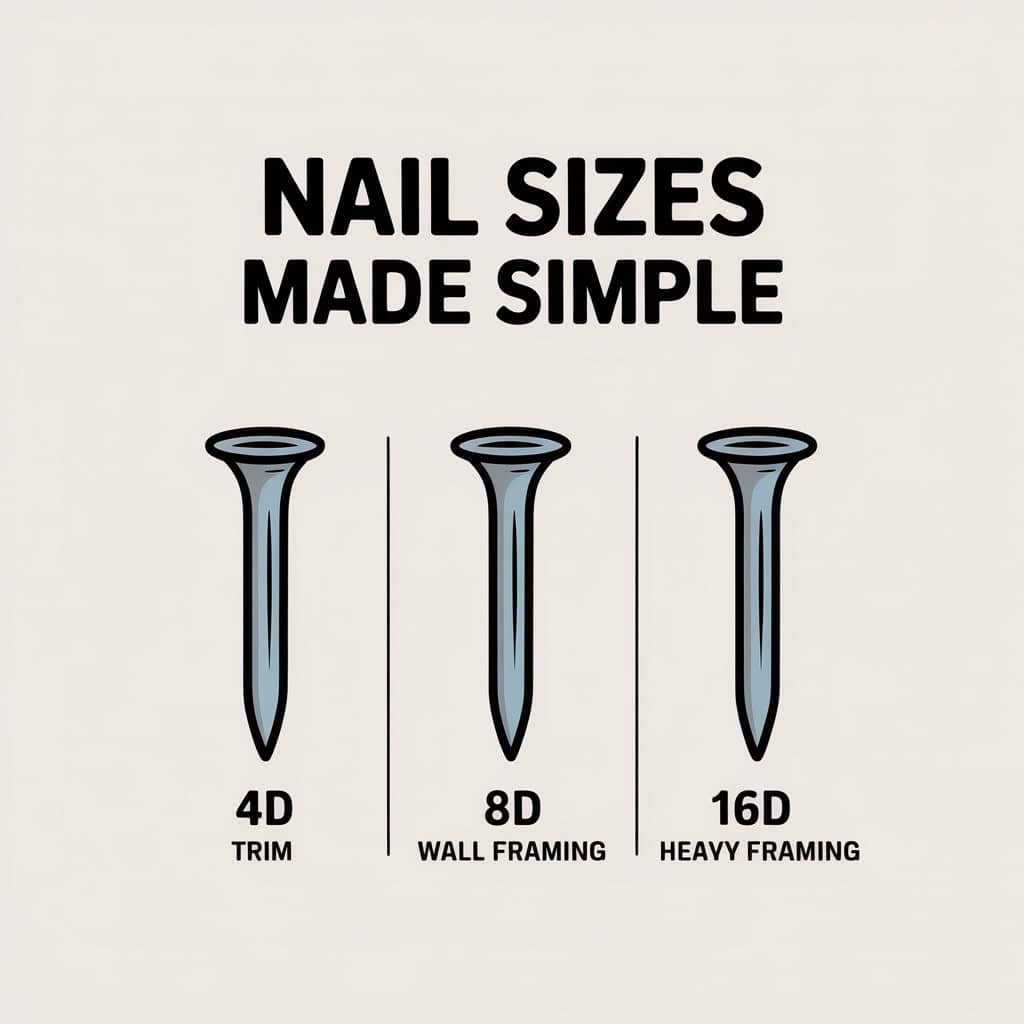If you’ve ever looked at a box of nails and wondered what “16d” or “8d” means, you’re not alone.
The “d” size label shows up in nearly every hardware store and building plan, but it’s not always clear what it stands for.
The “d” actually comes from an old Roman coin called the denarius. Later, in England, that “d” came to represent a penny in their currency system.
Back then, nails were priced by the hundred, and the number in front of the “d” told you how many pennies it would cost to buy 100 of that size nail. For example, 10d nails would cost 10 pennies per hundred.
Eventually, this pricing system turned into a sizing system. Today, “16d” doesn’t tell you the price—it tells you the nail’s general size. The higher the number, the longer and thicker the nail usually is.
Even though most modern boxes of nails also list the length in inches, the old “d” labels are still common in woodworking, framing, and general construction.
Understanding them helps you choose the right nail for the job and communicate clearly when reading project plans or asking for help at the hardware store.
Nail Size Conversion Chart
Here’s a quick reference chart to help you convert penny sizes into their actual lengths. Handy when planning a project or figuring out what size you really need:
| Size (d) | Length (inches) |
|---|---|
| 2d | 1.0 |
| 4d | 1.5 |
| 6d | 2.0 |
| 8d | 2.5 |
| 10d | 3.0 |
| 12d | 3.25 |
| 16d | 3.5 |
| 20d | 4.0 |
| 30d | 4.5 |
What Are Penny Nails Used For?

While the “d” size gives you the length, it doesn’t tell you everything.
Each size has a general purpose, but the type of nail matters too.
- 4d–6d nails: Good for trim, lattice work, and small finish jobs.
- 8d nails: Commonly used for framing walls, sheathing, and subflooring.
- 10d–12d nails: Often used for heavier framing and decking.
- 16d nails: Perfect for framing studs and general structural connections.
Knowing the right size and the right type of nail helps prevent issues like splitting wood, under- or over-penetration, and weak joints.
Types of Nails and How They Relate to Penny Sizes
Even if two nails are the same penny size, they can serve different purposes depending on their style.
Here are a few of the most common types:
- Common nails: Thick shank and large head. Ideal for structural work like framing.
- Box nails: Thinner shank than common nails. Good for lighter work and less likely to split wood.
- Finish nails: Smaller heads that can be countersunk. Great for baseboards, molding, and trim.
- Brad nails: Tiny nails used for fine trim and detailed projects. Usually under 2 inches long.
For example, an 8d common nail and an 8d box nail are both 2.5 inches long—but the box nail is thinner and better for finish work.
Why Nail Size Matters in Woodworking

Choosing the right nail isn’t just about getting it to hold—it’s about doing it cleanly and safely.
If your nail is too short, it won’t hold properly. Too long, and it could poke through your material. Too thick, and it might split the wood.
A good rule of thumb: your nail should be about 3 times as long as the material you’re fastening. If you’re attaching a 1/2″ board to something, a 1.5″ (4d) nail is usually just right.
You also want to consider the thickness of the nail. If you’re working with hardwoods or thin trim, using a thinner nail (like a box or finish nail) will help avoid splitting.
When to Use Screws Instead of Nails
While nails are often the go-to in framing and finish work, there are times when screws are the better choice.
- Use screws when working with hardwoods that might split.
- Use screws when you want stronger holding power for things like shelving, cabinets, or wall-mounted items.
- Use screws when you may need to remove or reposition the fastener later.
Nails are faster and cheaper, and they handle movement (shear force) well. Screws are slower but offer superior holding strength in many situations.
Use what’s best for the project.
How to Read Nail Packaging at the Store
Nail boxes can be confusing. Here’s what you’ll typically see:
“8d x 2-1/2 in. Bright Common Nails”
This means:
- 8d = penny size
- 2-1/2″ = actual nail length
- Bright = untreated, indoor use
- Common = thick shank with large head
If you’re working outdoors, look for hot-dipped galvanized or stainless steel nails to resist rust. Indoors, bright or coated nails are fine for most work.
Quick Reference Table: Nail Sizes and Their Common Uses
| Size (d) | Length | Best Use |
|---|---|---|
| 4d | 1.5″ | Small trim, cabinet backs |
| 6d | 2.0″ | Casing, thin boards, light framing |
| 8d | 2.5″ | General framing, sheathing |
| 10d | 3.0″ | Decking, subfloor, heavier framing |
| 12d | 3.25″ | Joists, ledgers, blocking |
| 16d | 3.5″ | Studs, headers, main framing |
Final Thoughts

The “d” system for nails might seem outdated, but it’s still widely used—and once you understand it, it’s pretty simple.
Just remember that the number in front of the “d” tells you the nail’s length, and different types of nails exist even within that size.
Choosing the right nail size and style is key to making strong, clean, long-lasting woodworking joints.
Whether you’re framing a wall, hanging trim, or working on furniture, getting the nail size right can make your work look and hold better.
